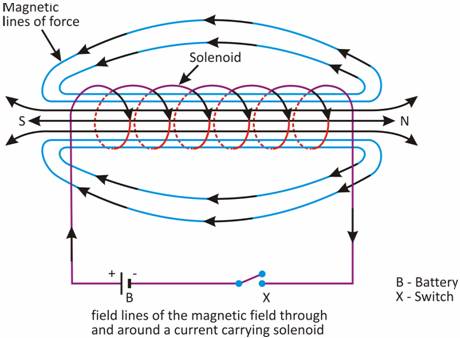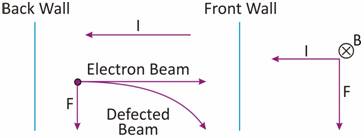Magnetic effect of current Worksheet-5
-
Name two safety measures commonly used in electric circuits and appliances.
-
An electric oven of a 2 kW power rating is operated in a domestic circuit (220 V) that has a current rating of 5 A. What result do you expect ? Explain.
-
What precaution should be taken to avoid the overloading of domestic electric circuits ?
-
List three sources of magnetic fields.
-
How does a solenoid behave like a magnet ? Can you determine the north and south poles of a current carrying solenoid with a help of bar magnet ? Explain.
-
When is the force experienced by a current-carrying conductor placed in a magnetic field is largest?
-
Imagine you are sitting in a chamber with your back to one wall. An electron beam, moving horizontally from back wall towards the front wall, is deflected by a strong magnetic field to your right side. What is the direction of the magnetic field ?
-
Name some devices in which electric motors are used.
-
A coil of insulated copper wire is connected to a galvanometer. What would happen if a bar magnet , is
(i) pushed into the coil ?
(ii) withdrawn from inside the coil ?
(iii) held stationary inside the coil ?
-
Two circular coils A and B are placed close to each other. If the current in the coil A is changed, will some current be induced in the coil B ? Give reason.
Answer:
-
(i) Fuse is used for protecting circuits due to short-circuiting or overloading of the circuits.
(ii) Earth wire is used to ensure that any leakage of current to the metallic body of an electric appliance should not give a severe shock to the user.
-
P = 2 kW = 2000 W, V = 220 V
I = =9A
=9A
Since the current rating of the circuit is 5 A and the current flowing through it is more (9 A), the fuse in the circuit melts. Consequently, the circuit is broken and the electric oven is saved from getting damaged.
-
To avoid overloading, many appliances should not be connected to a single socket.
-
(i) Natural and artificial magnets (ii) Electromagnets (iii) A conductor, a coil and a solenoid carrying current (iv) Earth.
-

The solenoid is a long coil containing a large number of close turns of insulated copper wire. The magnetic field produced by a current carrying solenoid is similar to the magnetic field produced by a bar magnet. One end of the current carrying solenoid acts like a north pole and the other end as a south pole. So if a current carrying solenoid is suspended freely, it will come to rest pointing in the north and south directions which is just like a bar magnet. To determine the polarities of its ends, place it in a brass hook and suspend it with a long thread so that it moves freely. Bring north pole of a bar magnet near one of its ends. In case the solenoid moves towards the bar magnet, that end of the solenoid is a south pole and in case the solenoid moves away from the magnet, that end of the solenoid is its north pole. The polarity of the other end of the solenoid can similarly be determined.
-
When the direction of the current is at right angle to the direction of the magnetic field.
-
The direction of current (I) is opposite to the direction of electron beam as shown in the figure. Since the beam is deflected to the right side, the force (F) acting on the beam is as shown. Applying Fleming's left hand rule, it is found that magnetic field (B) is acting vertically downwards (i.e., perpendicular to the plane of the paper and directed inwards) as shown by

-
Electric fans, water-pumps, coolers, refrigerators, mixers, blenders, washing machines etc.
-
(i) The magnetic flux linked with the coil changes in fact it increases. As a result of this, an induced current flows in the coil and the galvanometer shows a momentary deflection, the needle of the galvanometer moves momentarily in one direction.
(ii) The magnetic flux linked with the coil changes or decreases. As a result of this, an induced current flows in the coil but in a direction opposite to that in case (i) The galvanometer momentarily shows a deflection in the opposite direction, the needle of the galvanometer moves momentarily but in the opposite direction to (i).
(iii) When the magnet is stationary in the coil, there will be a magnetic flux in the coil but it will remain constant. Since the magnetic flux does not change, there is no induced current in the coil and the galvanometer shows no deflection.
-
By changing current in the coil A, a current will be induced in the coil B which is placed closer to A. Because that magnetic field lines linked with A also get linked with B due to its being close to A. When the current in coil A changes, magnetic field lines linked with A change. so, magnetic field lines linked with B also changed. As a result of this, current is induced in the coil B. This phenomenon is called mutual induction.
![]() =9A
=9A
